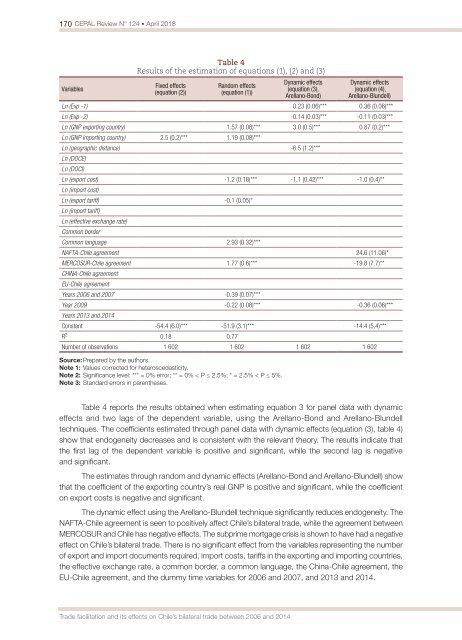CEPAL Review no. 124
April 2018
April 2018
Create successful ePaper yourself
Turn your PDF publications into a flip-book with our unique Google optimized e-Paper software.
170 <strong>CEPAL</strong> <strong>Review</strong> N° <strong>124</strong> • April 2018<br />
Variables<br />
Table 4<br />
Results of the estimation of equations (1), (2) and (3)<br />
Fixed effects<br />
(equation (2))<br />
Random effects<br />
(equation (1))<br />
Dynamic effects<br />
(equation (3),<br />
Arella<strong>no</strong>-Bond)<br />
Dynamic effects<br />
(equation (4),<br />
Arella<strong>no</strong>-Blundell)<br />
Ln (Exp -1) 0.23 (0.06)*** 0.36 (0.06)***<br />
Ln (Exp -2) -0.14 (0.03)*** -0.11 (0.03)***<br />
Ln (GNP exporting country) 1.57 (0.08)*** 3.0 (0.5)*** 0.87 (0.2)***<br />
Ln (GNP importing country) 2.5 (0.2)*** 1.19 (0.08)***<br />
Ln (geographic distance) -6.5 (1.2)***<br />
Ln (DOCE)<br />
Ln (DOCI)<br />
Ln (export cost) -1.2 (0.18)*** -1.1 (0.42)*** -1.0 (0.4)**<br />
Ln (import cost)<br />
Ln (export tariff) -0.1 (0.05)*<br />
Ln (import tariff)<br />
Ln (effective exchange rate)<br />
Common border<br />
Common language 2.93 (0.32)***<br />
NAFTA-Chile agreement 24.6 (11.06)*<br />
MERCOSUR-Chile agreement 1.77 (0.6)*** -19.8 (7.7)**<br />
CHINA-Chile agreement<br />
EU-Chile agreement<br />
Years 2006 and 2007 -0.39 (0.07)***<br />
Year 2009 -0.22 (0.08)*** -0.36 (0.06)***<br />
Years 2013 and 2014<br />
Constant -54.4 (6.0)*** -51.9 (3.1)*** -14.4 (5.4)***<br />
R 2 0.18 0.77<br />
Number of observations 1 602 1 602 1 602 1 602<br />
Source: Prepared by the authors.<br />
Note 1: Values corrected for heteroscedasticity.<br />
Note 2: Significance level: *** = 0% error; ** = 0% < P ≤ 2.5%; * = 2.5% < P ≤ 5%.<br />
Note 3: Standard errors in parentheses.<br />
Table 4 reports the results obtained when estimating equation 3 for panel data with dynamic<br />
effects and two lags of the dependent variable, using the Arella<strong>no</strong>-Bond and Arella<strong>no</strong>-Blundell<br />
techniques. The coefficients estimated through panel data with dynamic effects (equation (3), table 4)<br />
show that endogeneity decreases and is consistent with the relevant theory. The results indicate that<br />
the first lag of the dependent variable is positive and significant, while the second lag is negative<br />
and significant.<br />
The estimates through random and dynamic effects (Arella<strong>no</strong>-Bond and Arella<strong>no</strong>-Blundell) show<br />
that the coefficient of the exporting country’s real GNP is positive and significant, while the coefficient<br />
on export costs is negative and significant.<br />
The dynamic effect using the Arella<strong>no</strong>-Blundell technique significantly reduces endogeneity. The<br />
NAFTA-Chile agreement is seen to positively affect Chile’s bilateral trade, while the agreement between<br />
MERCOSUR and Chile has negative effects. The subprime mortgage crisis is shown to have had a negative<br />
effect on Chile’s bilateral trade. There is <strong>no</strong> significant effect from the variables representing the number<br />
of export and import documents required, import costs, tariffs in the exporting and importing countries,<br />
the effective exchange rate, a common border, a common language, the China-Chile agreement, the<br />
EU-Chile agreement, and the dummy time variables for 2006 and 2007, and 2013 and 2014.<br />
Trade facilitation and its effects on Chile’s bilateral trade between 2006 and 2014


















